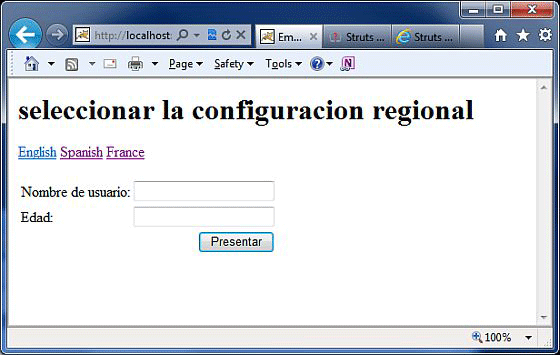本地化
国际化(i18n)是规划和实施产品和服务,以便他们可以很容易地适应特定的本地语言和文化的过程,这个过程被称为本地化。国际化过程有时被称为翻译或本地化启用。国际化缩写为 i18n,因为这个单词以 i 开始,以 n 结束,而且第一个 i 和最后的 n 之间有 18 个字符。
Struts2 提供本地化,即国际化(i18n)支持,通过使用下面的资源包,拦截器和标签库:
-
UI标签
-
消息和错误
- 动作类内
资源包
Struts 2 使用资源包来给 Web 应用程序的用户提供多种语言和本地化选项。你不必担心用不同的语言编写网页。你所要做的是为每个你想要的语言创建一个资源包。这个资源包将包含你的用户语言的标题,消息和其他文本。资源包是包含使用你的应用程序的默认语言的键/值对的文件。
对资源文件最简单的命名格式是:
bundlename_language_country.properties这里,bundlename 可以是动作类,接口,超类,模型,包,全局资源属性。接下来的部分语言**_**国家代表国家地区,例如 Spanish (Spain) 地区用 es_ES 代表,English (United States) 地区用 en_US 代表等等。这里你可以跳过可选的国家部分。
当你用它的键引用消息元素时,Struts 框架按照下列顺序进行检索相应的消息:
- ActionClass.properties
- Interface.properties
- SuperClass.properties
- model.properties
- package.properties
- struts.properties
- global.properties
为了用多种语言开发你的应用程序,你将不得不保留多个对应于这些语言/地区的属性文件相,并且根据键/值对定义所有的内容。例如,如果你要为美国英语(默认),西班牙语,和法语开发应用程序,你就必须创建三个属性文件。这里,我将只使用 global.properties 文件,你可以利用不同的属性文件来隔离不同类型的消息。
- global.properties:默认情况下,英语(美国)将被应用
- global_fr.properties:这将用于法语环境。
- global_es.properties:这将被用于西班牙语言环境。
访问信息
有几种方法可以访问信息资源,包括 getText,文本标签,UI 标签的键属性和国际化标签。让我们来看看他们,如下简单地说:
为了显示 i18n 的文本,在属性标签或其他任何标签中调用 getText,例如 UI 标签,如下所示:
<s:property value="getText('some.key')" />文本标签检索默认的资源包的信息,即 struts.properties
<s:text name="some.key" />i18n 标签把任意资源包放进值栈中。i18n 标签范围内的其他标签可以显示该资源包的信息:
<s:i18n name="some.package.bundle">
<s:text name="some.key" />
</s:i18n>大多数 UI 标签的键属性,可以用来检索一个资源包的消息:
<s:textfield key="some.key" name="textfieldName"/>本地化例子
让我们把前一章中用多种语言创建的 index.jsp 作为目标。相同的文件将被编写,如下所示:
<%@ page language="java" contentType="text/html; charset=ISO-8859-1"
pageEncoding="ISO-8859-1"%>
<%@ taglib prefix="s" uri="/struts-tags"%>
<!DOCTYPE html PUBLIC "-//W3C//DTD HTML 4.01 Transitional//EN"
"http://www.w3.org/TR/html4/loose.dtd">
<html>
<head>
<title>Employee Form with Multilingual Support</title>
</head>
<body>
<h1><s:text name="global.heading"/></h1>
<s:url id="indexEN" namespace="/" action="locale" >
<s:param name="request_locale" >en</s:param>
</s:url>
<s:url id="indexES" namespace="/" action="locale" >
<s:param name="request_locale" >es</s:param>
</s:url>
<s:url id="indexFR" namespace="/" action="locale" >
<s:param name="request_locale" >fr</s:param>
</s:url>
<s:a href="%{indexEN}" >English</s:a>
<s:a href="%{indexES}" >Spanish</s:a>
<s:a href="%{indexFR}" >France</s:a>
<s:form action="empinfo" method="post" namespace="/">
<s:textfield name="name" key="global.name" size="20" />
<s:textfield name="age" key="global.age" size="20" />
<s:submit name="submit" key="global.submit" />
</s:form>
</body>
</html>
我们将创建 success.jsp 文件,假如动作返回 SUCCESS,该文件将被调用。
<%@ page language="java" contentType="text/html; charset=ISO-8859-1"
pageEncoding="ISO-8859-1"%>
<%@ taglib prefix="s" uri="/struts-tags"%>
<!DOCTYPE html PUBLIC "-//W3C//DTD HTML 4.01 Transitional//EN"
"http://www.w3.org/TR/html4/loose.dtd">
<html>
<head>
<title>Success</title>
</head>
<body>
<s:property value="getText('global.success')" />
</body>
</html>
这里,我们需要创建下面的两个动作。(a)第一个动作监督区域,显示相同的用不同的语言编写的 index.jsp 文件(b)另一个行动是为了监督提交表单本身。动作都将返回 SUCCESS,但根据返回值,我们会采取不同的动作,因为对两个动作来说我们的目的是不同的:
监督区域的动作
package com.tutorialspoint.struts2;
import com.opensymphony.xwork2.ActionSupport;
public class Locale extends ActionSupport{
public String execute()
{
return SUCCESS;
}
}提交表单的动作
package com.tutorialspoint.struts2;
import com.opensymphony.xwork2.ActionSupport;
public class Employee extends ActionSupport{
private String name;
private int age;
public String execute()
{
return SUCCESS;
}
public String getName() {
return name;
}
public void setName(String name) {
this.name = name;
}
public int getAge() {
return age;
}
public void setAge(int age) {
this.age = age;
}
}现在,让我们创建下面三个 global.properties 文件,并且把它们放在 CLASSPATH 中:
global.properties
global.name = Name
global.age = Age
global.submit = Submit
global.heading = Select Locale
global.success = Successfully authenticatedglobal_fr.properties
global.name = Nom d'utilisateur
global.age = l'âge
global.submit = Soumettre des
global.heading = Sé lectionnez Local
global.success = Authentifi é avec succèsglobal_es.properties
global.name = Nombre de usuario
global.age = Edad
global.submit = Presentar
global.heading = seleccionar la configuracion regional
global.success = Autenticado correctamente我们将创建带有两个动作的 struts.xml,如下所示:
<?xml version="1.0" encoding="UTF-8"?>
<!DOCTYPE struts PUBLIC
"-//Apache Software Foundation//DTD Struts Configuration 2.0//EN"
"http://struts.apache.org/dtds/struts-2.0.dtd">
<struts>
<constant name="struts.devMode" value="true" />
<constant name="struts.custom.i18n.resources" value="global" />
<package name="helloworld" extends="struts-default" namespace="/">
<action name="empinfo"
class="com.tutorialspoint.struts2.Employee"
method="execute">
<result name="input">/index.jsp</result>
<result name="success">/success.jsp</result>
</action>
<action name="locale"
class="com.tutorialspoint.struts2.Locale"
method="execute">
<result name="success">/index.jsp</result>
</action>
</package>
</struts>下面是 web.xml 文件中的内容:
<?xml version="1.0" encoding="UTF-8"?>
<web-app xmlns:xsi="http://www.w3.org/2001/XMLSchema-instance"
xmlns="http://java.sun.com/xml/ns/javaee"
xmlns:web="http://java.sun.com/xml/ns/javaee/web-app_2_5.xsd"
xsi:schemaLocation="http://java.sun.com/xml/ns/javaee
http://java.sun.com/xml/ns/javaee/web-app_3_0.xsd"
id="WebApp_ID" version="3.0">
<display-name>Struts 2</display-name>
<welcome-file-list>
<welcome-file>index.jsp</welcome-file>
</welcome-file-list>
<filter>
<filter-name>struts2</filter-name>
<filter-class>
org.apache.struts2.dispatcher.FilterDispatcher
</filter-class>
</filter>
<filter-mapping>
<filter-name>struts2</filter-name>
<url-pattern>/*</url-pattern>
</filter-mapping>
</web-app>现在,右键点击项目名称,并单击 Export > WAR File 创建一个 WAR 文件。然后部署此 WAR 在 Tomcat 的 webapps 目录下。最后,启动 Tomcat 服务器和尝试访问 URL http://localhost:8080/HelloWorldStruts2/index.jsp. 这会给出以下画面:

现在选择任何一种语言,假如说我们选择西班牙语,它将显示下面的结果:

同样,你可以尝试用法语。最后,当我们使用西班牙语言时,让我们尝试单击 Submit 按钮,它会显示下面的画面:

恭喜你,现在你有一个多语言的网页,你可以在全局范围内启动你的网站。